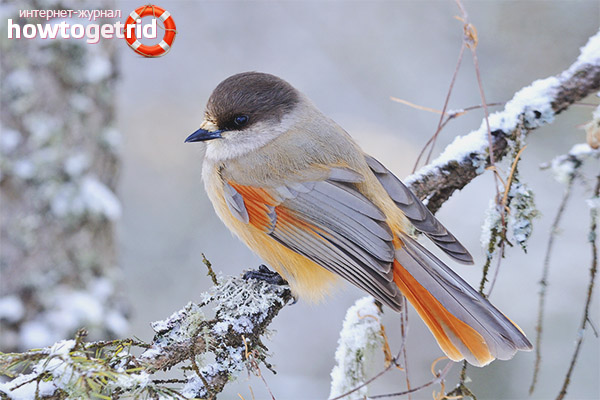The content of the article
The one who first saw the flight of the kuksha certainly begins to admire the emerging beauty. The bird is really beautiful, and deserves close attention, both from ornithologists and ordinary inhabitants.
This feathered representative did not receive such a somewhat unusual name. When a bird screams, it is akin to the muffled sound of “cuuk”. The variety of Russian dialects implies many other names for this representative of the bird kingdom. For example, one of the characters in Boris Pasternak’s novel “Doctor Zhivago,” calls her “Ronja”. So they call her in the Urals.
External characteristics
Kuksha is part of the order Passeriformes, a family of corvidae. Outwardly, it bears a great resemblance to a jay. Very beautiful is the flight of this bird. During it, her wings take the shape of a circle. It is difficult to disagree with the fact that such a picture is rarely observed. The tail has a bright orange color. When a bird goes flying, it becomes very large in width. The thin paws of a feathered representative are characterized by a gray color. A small head is crowned by a small dark beak.
The total size of the bird is small, and the weight does not exceed 110 grams. The body can reach a length of 27 cm. There is a difference in the plumage of a male and a female, but it is so insignificant that it is difficult for a specialist to notice.
Power characteristics
Often worms are present in her diet. Along with animal food, kuksha is not averse to feasting on plant-derived foods. It can be seeds of various cereal crops. The bird will not deny itself the pleasure of enjoying berries and fruits. An interesting fact is that even mushrooms can be present in her diet. Very often, in search of food, a bird flies into the yards of people's homes.
Propagation Features
In early spring, these birds actively form pairs. During this period, you can often observe bird "showdown". Male youth does everything possible and even impossible so that the female turns her attention to young feathered representatives. When the male nevertheless achieves the desired, a pair is formed. Using improvised material, the male and the female jointly organize a nest on a tree. Absolutely everything is used, from branches to dry grass. In the finished nest, the female lays up to 5 eggs. After that, she sets up on them and begins to hatch the chicks. Of course, the male also helps in this second half, but nevertheless, basically, in this action he is assigned the role of a guard.
The female will sit on eggs for almost three weeks. After this, chicks appear. Until the birds begin to fly, the whole family is busy feeding them. However, even at a more mature age, parents gradually feed their pets. Characteristically, the family is distinguished by strong friendship.
Being in the wild, the bird is able to live up to 12 years.
Some interesting facts
The behavior of kuksha can sometimes be unusual:
- Even in the event of a clear threat, the female will never leave the nest.
- In the literature, cases are described when a female ate chicks from neighboring nests.
- A brood from neighboring nests, combined, can form a large group. In this composition, they travel and get food.
Habitat characterization
The bird is well known to residents of the northern regions, since most of it lives there. Residents of other regions have less idea of this bird. Pretty early, the kuksha learns to sing. However, at first it looks like incoherent, slurred mumble. When a bird becomes more mature, its singing is so delightful that you can just listen to it. The singing of kuksha is somewhat reminiscent of that of a bullfinch. But the bird sings very quietly, so it can not always be heard.
Video: kuksha (Perisoreus infaustus)











Submit